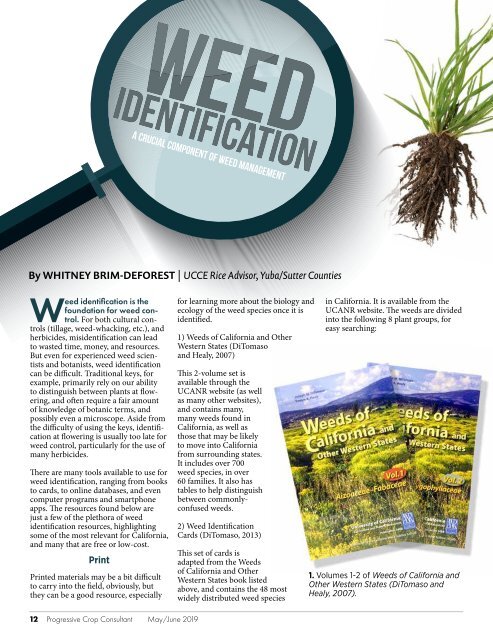PCC_MayJun_2019_e
Create successful ePaper yourself
Turn your PDF publications into a flip-book with our unique Google optimized e-Paper software.
By WHITNEY BRIM-DEFOREST | UCCE Rice Advisor, Yuba/Sutter Counties<br />
Weed identification is the<br />
foundation for weed control.<br />
For both cultural controls<br />
(tillage, weed-whacking, etc.), and<br />
herbicides, misidentification can lead<br />
to wasted time, money, and resources.<br />
But even for experienced weed scientists<br />
and botanists, weed identification<br />
can be difficult. Traditional keys, for<br />
example, primarily rely on our ability<br />
to distinguish between plants at flowering,<br />
and often require a fair amount<br />
of knowledge of botanic terms, and<br />
possibly even a microscope. Aside from<br />
the difficulty of using the keys, identification<br />
at flowering is usually too late for<br />
weed control, particularly for the use of<br />
many herbicides.<br />
There are many tools available to use for<br />
weed identification, ranging from books<br />
to cards, to online databases, and even<br />
computer programs and smartphone<br />
apps. The resources found below are<br />
just a few of the plethora of weed<br />
identification resources, highlighting<br />
some of the most relevant for California,<br />
and many that are free or low-cost.<br />
Print<br />
Printed materials may be a bit difficult<br />
to carry into the field, obviously, but<br />
they can be a good resource, especially<br />
for learning more about the biology and<br />
ecology of the weed species once it is<br />
identified.<br />
1) Weeds of California and Other<br />
Western States (DiTomaso<br />
and Healy, 2007)<br />
This 2-volume set is<br />
available through the<br />
UCANR website (as well<br />
as many other websites),<br />
and contains many,<br />
many weeds found in<br />
California, as well as<br />
those that may be likely<br />
to move into California<br />
from surrounding states.<br />
It includes over 700<br />
weed species, in over<br />
60 families. It also has<br />
tables to help distinguish<br />
between commonlyconfused<br />
weeds.<br />
2) Weed Identification<br />
Cards (DiTomaso, 2013)<br />
This set of cards is<br />
adapted from the Weeds<br />
of California and Other<br />
Western States book listed<br />
above, and contains the 48 most<br />
widely distributed weed species<br />
in California. It is available from the<br />
UCANR website. The weeds are divided<br />
into the following 8 plant groups, for<br />
easy searching:<br />
1. Volumes 1-2 of Weeds of California and<br />
Other Western States (DiTomaso and<br />
Healy, 2007).<br />
12 Progressive Crop Consultant May/June <strong>2019</strong>


















